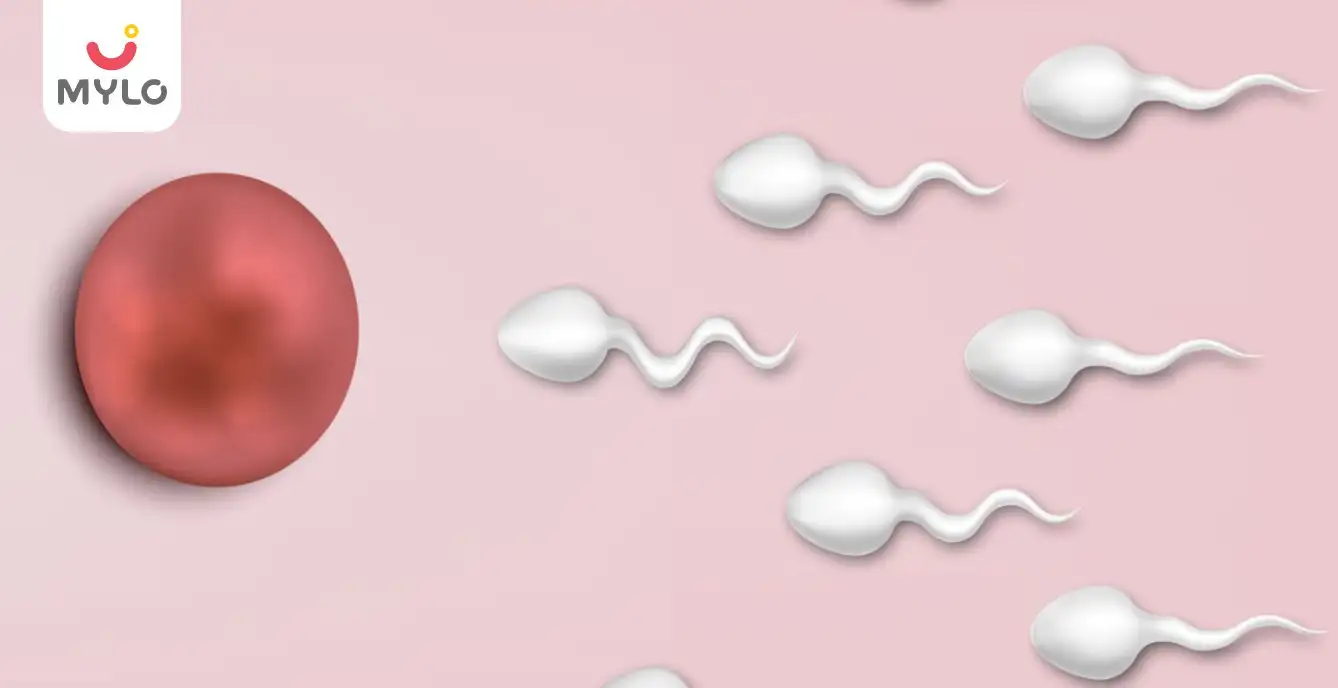
Trying to get pregnant?
Take the Test
Article Continues below advertisement
- Home

- Cervical Mucus: The Ultimate Handbook on Ovulation Discharge
In this Article
Getting Pregnant
Cervical Mucus: The Ultimate Handbook on Ovulation Discharge
Updated on 14 December 2023



Medically Reviewed by
Kusum Sabharwal
Obstetrician & Gynecologist - MBBS| DGO
View Profile

Article Continues below advertisement
Have you ever wondered why some women seem to effortlessly conceive while others struggle? Well, the secret may lie in something as simple as cervical mucus. Yes, you heard that right! Cervical or ovulation mucus plays a vital role in a woman's fertility journey, and understanding its patterns and changes can be the key to unlocking the doors of successful conception.
In this article, we'll understand more about its significance, how it changes throughout the menstrual cycle, and how you can use this knowledge to your advantage.
Cervical mucus meaning
Cervical mucus, also known as cervical fluid, is a substance produced by the cervix in response to hormonal changes during a woman's menstrual cycle. It plays a crucial role in fertility as it provides nourishment and protection for sperm, helping them survive and travel through the reproductive system to fertilize an egg.
Its consistency and appearance changes throughout the menstrual cycle, reflecting the different stages of ovulation. By understanding these changes, women can track their fertility and increase their chances of conceiving.
You may also like: What is Cervical Mucus Method & How to Check?
Article continues below advertisment
Ovulation discharge stages
During a typical menstrual cycle, there are several stages of ovulation mucus. The first stage is known as "dry days," where little to no cervical mucus is present. As the cycle progresses, the mucus becomes sticky or creamy, acting as a barrier to sperm.
As ovulation approaches, the mucus becomes more abundant, slippery, and stretchy. This is known as "egg white cervical mucus" (EWCM) due to its resemblance to raw egg whites. EWCM is considered the most fertile ovulation discharge as it facilitates sperm movement and promotes successful fertilization.
Cervical mucus after ovulation gradually decreases in quantity and returns to a sticky or dry consistency. This marks the end of the fertile phase of the menstrual cycle.
What does fertile ovulation discharge look like?
Fertile ovulation discharge, specifically the egg white cervical mucus, has distinct characteristics that indicate a woman's peak fertility. It is clear, slippery, and stretchy. The ovulation discharge color resembles raw egg whites. When observed between the fingers, it can be stretched without breaking easily.
The purpose of this fertile cervical mucus is to create a hospitable environment for sperm, allowing them to swim freely and survive longer within the reproductive tract. It also helps to guide the sperm through the cervix and into the uterus, increasing the likelihood of fertilization.
Article continues below advertisment
You may also like: What Are the Signs of Ovulation & How to Estimate When You're Ovulating to Boost Chances of Pregnancy?
How long after egg white cervical mucus do you ovulate?
The presence of egg white cervical mucus indicates that ovulation is approaching or has already occurred. Typically, ovulation occurs within 24 to 48 hours after the last day of abundant, stretchy cervical mucus. However, it is important to note that every woman's body is unique, and ovulation may vary from person to person.
To increase the accuracy of tracking ovulation, it is recommended to use additional methods such as basal body temperature charting or ovulation predictor kits. These methods can provide a more precise indication of when ovulation is likely to occur.
How to check cervical mucus during ovulation?
Checking cervical mucus during ovulation requires simple observation and awareness of changes in consistency and appearance.
1. Manually
Start by washing and drying your hands. Find a comfortable position and insert 2 clean fingers in your vagina and swab your cervix.
Article continues below advertisment
2. Surgical swab
You can get a sterile swab from a nearby pharmacist. This thick bud of cotton swab is mostly used by doctors to collect the sample.
3. Check underwear or a panty liner
A lot of women use panty liners to stay dry when they have to stay too long out of the house. Before using the washroom, you can have a look at your deposited cervical mucus on your panty liner or underwear.
4. Toilet paper
A lot of women use toilet paper after peeing. If you can insert the toilet paper a little deeper into your vagina then you will get some amount of cervical mucus on the toilet paper. Although it will not detect clear results because paper can absorb some amount of mucus. To avoid infections, make sure the toilet paper is clean.
You may also like: White Creamy Discharge: Is It Normal or a Cause for Concern?
Points to remember
By understanding your unique cervical mucus patterns, you can optimize your chances of conception. Here are some tips to keep in mind:
Article continues below advertisment
- Observe the ovulation discharge color and texture on your finger or toilet paper.
- Note any changes in consistency, such as dryness, stickiness, creaminess, or the presence of egg white-like mucus.
- Avoid checking your CM during or right after sex
- If you are uncomfortable putting your fingers inside the vagina then you can notice it on your underwear or toilet paper.
- Consider checking your CM after bowel movements
- Take note of these changes and record them in a fertility tracking app or journal.
- It is essential to track your ovulation discharge consistently for several cycles to identify patterns and accurately predict ovulation.
Is it normal to observe cervical mucus after ovulation?
Observing mucus after ovulation is entirely normal and expected. After ovulation, the cervical mucus gradually decreases in quantity and changes in consistency. It may become sticky, tacky, or dry. This change is due to the decrease in estrogen levels and the transition of the body from the fertile phase to the non-fertile phase of the menstrual cycle.
The absence of cervical mucus post ovulation is a common sign that the fertile window has closed, and the chances of conceiving during that cycle are significantly reduced. However, it is still important to track other fertility signs, such as basal body temperature, to confirm ovulation and ensure accurate fertility prediction.
You may also like: White Discharge After Ovulation: A Normal Occurrence or Cause for Concern?
What are the factors affecting cervical mucus?
While cervical mucus is primarily influenced by hormonal changes during the menstrual cycle, several factors can affect its quality and production. Here are five factors that can impact it:
Article continues below advertisment
1. Hormonal imbalances
Hormonal imbalances, such as polycystic ovary syndrome (PCOS) or thyroid disorders, can alter cervical mucus production and consistency.
2. Medications
Certain medications, such as antihistamines or decongestants, can cause dryness and decrease cervical mucus production.
3. Dehydration
Inadequate hydration can lead to reduced cervical mucus production. Staying well-hydrated is essential for maintaining optimal cervical mucus quality.
4. Age
As women age, their cervical mucus production tends to decrease, which can impact fertility.
5. Infections or inflammation
Infections or inflammation in the reproductive tract can disrupt normal cervical mucus production and consistency.
Article continues below advertisment
Understanding these factors and addressing any underlying issues can help improve cervical mucus quality and promote fertility.
When to see a doctor?
While changes in cervical fluid are a normal part of the menstrual cycle, certain symptoms may indicate an underlying issue. It is advisable to consult a doctor if you experience any of the following:
1. Persistent abnormal discharge
If you notice changes in color, odor, or consistency of your cervical mucus that are not consistent with your normal pattern, it is important to seek medical advice.
You may also like: Types of Vaginal Discharge, What They Mean and What is Normal?
2. Pain or discomfort
If you experience pain, discomfort, or itching along with changes in the mucus, it may indicate an infection or other medical condition.
Article continues below advertisment
3. Difficulty conceiving
If you have been actively trying to conceive for an extended period without success, consulting a fertility specialist can help identify any potential issues.
A healthcare professional can provide guidance, perform necessary tests, and offer personalized advice based on your specific circumstances.
FAQs
1. Do you observe cervical mucus after ovulation if pregnant?
Yes, it is possible to observe white discharge after ovulation if pregnant. In early pregnancy, cervical mucus may increase in quantity and have a different consistency. It may also have a pink tinge if there is implantation bleeding. However, not everyone experiences these changes, and cervical mucus naturally changes throughout the menstrual cycle. The most reliable indicator of pregnancy is a positive test result after a missed period.
2. How long after egg white cervical mucus do you ovulate?
After the appearance of egg white cervical mucus, ovulation typically occurs within 24 to 48 hours. The presence of egg white cervical mucus indicates that the body is preparing for ovulation, and it is a sign of increased fertility. This type of cervical mucus is thin, watery, and slippery, which helps sperm swim through the vagina and reach the egg for fertilization.
3. What is the difference between ovulation discharge vs pregnancy discharge?
Article continues below advertisment
The main difference between these two discharges lies in their timing and consistency. Ovulation discharge occurs just before and during ovulation. It is typically wet, slippery, stretchy, and resembles raw egg whites. On the other hand, pregnancy discharge can occur after implantation, around the time of a missed period. It may remain thick, clear, and stretchy due to rising hormone levels.
Key Takeaways
Understanding cervical mucus and its role in the menstrual cycle is crucial for women who are trying to conceive. By tracking ovulation discharge stages, women can identify their fertile window and increase their chances of successful conception. Remember to observe the characteristics of fertile ovulation discharge and track any changes in consistency. If you have concerns or difficulties conceiving, it is advisable to seek medical advice from a healthcare professional.
References
1. Fehring RJ, Schneider M, Raviele K, Barron ML. (2007). Efficacy of cervical mucus observations plus electronic hormonal fertility monitoring as a method of natural family planning. NCBI
2. Jamie L. Bigelow, David B. Dunson, Joseph B. Stanford, René Ecochard, Christian Gnoth, Bernardo Colombo. (2004). Mucus observations in the fertile window: a better predictor of conception than timing of intercourse. Hum Reprod.
Article continues below advertisment





Medically Reviewed by
Kusum Sabharwal
Obstetrician & Gynecologist - MBBS| DGO
View Profile


Written by
Priyanka Verma
Priyanka is an experienced editor & content writer with great attention to detail. Mother to a 10-year-old, she's skille
Read MoreGet baby's diet chart, and growth tips

Related Articles
Related Topics
Products you may like
RECENTLY PUBLISHED ARTICLES
our most recent articles

Ovaries
Bulky Ovaries Explained: What Every Woman Should Be Aware Of

Getting Pregnant
Ovulation: The Key to Maximizing Your Chances of Conception and Pregnancy

Fun & Humour
The Ultimate Compilation of Fancy Dress Ideas for Young Kids

Conception
How Long Does Sperm Take to Reach the Egg?

Ovulation
Pregnancy Symptoms After Ovulation Day by Day: Exploring the Daily Progression

Ovulation
Signs Ovulation is Over: Your Guide to Understanding the End of Ovulation
- Top 15 Akbar and Birbal Stories for Young Kids
- How Soon After an Abortion Can You Get Pregnant?
- PCOS and Sex: Exploring Impact on Health and Debunking Common Myths
- Papaya for PCOS: Exploring the Link and How It Can Positively Impact Your Health
- How to Boost Fertility in Your 30s: The Ultimate Guide
- Anovulation Meaning Explained: What You Need to Know About Its Causes & Treatment
- Basal Body Temperature: How It Can Help You Track Ovulation?
- Ovulation Pain: Is It Normal or a Cause for Concern?
- Special Home Remedies For Gas During Pregnancy
- PCOD Problem After Marriage: Debunking Common Misconceptions and Finding Solutions
- White Discharge After Ovulation: A Normal Occurrence or Cause for Concern?
- Normal Ovary Size: How It Varies and What It Means for You
- 2024 Calendar with Holidays and Festivals of India
- After-Abortion Sex: A Guide to Physical and Emotional Wellness

At Mylo, we help young parents raise happy and healthy families with our innovative new-age solutions:
- Mylo Care: Effective and science-backed personal care and wellness solutions for a joyful you.
- Mylo Baby: Science-backed, gentle and effective personal care & hygiene range for your little one.
- Mylo Community: Trusted and empathetic community of 10mn+ parents and experts.
Product Categories
baby carrier | baby soap | baby wipes | baby shampoo | baby lotion | baby powder | baby body wash | stretch marks cream | stretch marks oil | baby cream | baby massage oil | baby hair oil |








